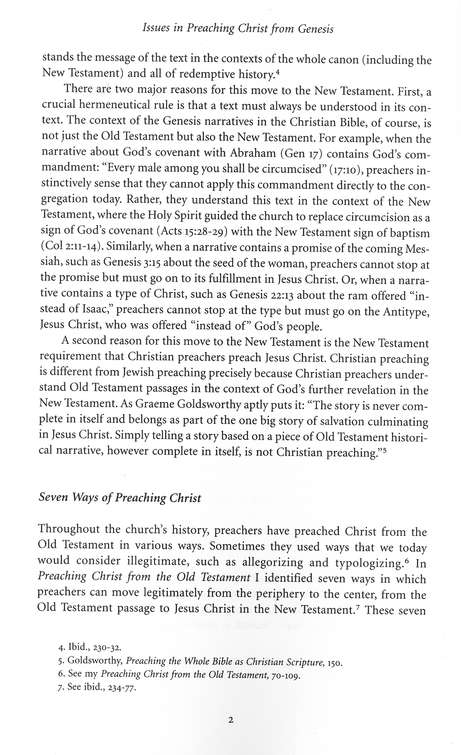This is a series of articles on how to preach Christ in the Old Testament. Many have mistakenly preached using the Old Testament for moralistic preaching or self-help. Preacher, do you want to learn to preach on the basis of the Old Testament?Series of articles will give you a good introduction.
?Are you searching the scriptures, [?] Those who bear witness to me;
(Jesus? John 5:39)
A definition can be found on the Biblical University Alliance website that clearly illustrates what the Exemplary Biographical Sermon is 😕 The biographical sermon is a specific type of sermon that aims to expose the life of a biblical character as a model of faith and an example of behavior. Koller indicates that the biographical sermon is one that “is based on a person and not on a central truth. ” Lloyd Perry explains that the biography is mainly about people and, incidentally, events, while the story is reversed. Thus, the biographical sermon is one that deals with biblical characters and the events of which they are protagonists. It is easy to see that many of the stories in the Bible can serve this purpose, so viewed in this way they can become an important source of material for the preacher. Perry says, with some exaggeration, that there is an endless supply of biblical material for preaching biographical sermons, noting that there are 2,930 different characters in the scriptures.
Perry points out the benefits of biographical preaching:
Preaching on biblical characters gives the minister the opportunity to clearly present the modern equivalent of a biblical character’s experience. The use of this type of subjective topic helps bring the scriptures to life with people who have been confronted with real situations and with whom God has been. immediately occupied and intimately involved in life, difficulties, hopes and relationships.
For him, the biographical sermon is a great way to demonstrate the contemporary relevance of the scriptures. Greidanus points out that this approach is the result of man’s quest for the meaning of past events, the relevance of history, hence its universal appeal. Koller notes that preaching about biblical characters is perhaps “the easiest way to preach the Bible, which is more likely to attract people and keep their attention, and what will most be remembered. “It is no coincidence that the exemplary approach to biographical preaching is so widespread.
Greidanus points out that Clement, the father of the church, has already used the exemplary approach extensively. Clemente viewed the Bible as an “ethical model book. ” There were good models, worthy of imitation, like the patriarchs, Moses, Job, Rahab, David; and bad examples, whose attitudes must be avoided, like Urín, the wife of Lot and Esau.
Justino Wasrtir reports that preachers liked to choose a historical text and urge listeners to follow the good example presented. In the Middle Ages, Old Testament preaching was recommended because “their stories fascinated people and reflected their lives. “
Even Luther and Calvin were still influenced by the exemplary approach. Reu quotes Luther: “Is this the correct understanding of the entire Old Testament? Remember the wonderful words of the prophets about Christ, understand and observe admirable examples, and use the laws as we please and do them in our favor? According to Reu, in this question, something similar can be pointed out about Zingling and Calvin 😕 Zinging’s sermons, and in particular Calvin’s, on the Old Testament have the following characteristics in common with those of Luther: They present the Old Testament saints as examples of standard and warning. According to Huyser:
All later preachers of the Reformed tradition (Orthodox Lutherans, Calvinists, Puritans, Pietists, Methodists, and Baptists) followed in the footsteps of Luther and Calvin. Did they see it not only as their right, but also as their sacred duty? Interpret and apply the biblical story in an example and thus draw the line from past to present.
Braga explains the process of performing a biographical sermon: “Starting with a fairly extensive passage that deals with a biblical character, we can look for other references to that person and form a framework for a biographical sermon plan. “
According to Perry, collecting sermon material should include investigating the meaning of the character’s name, his family history, the religious or secular crises he has faced, the friendships he has developed, the gaps and failures that could serve as a warning, his contributions. For your time and for posterity. This indicates that the preacher should be attentive to any ideas that such information may suggest and seek to satisfy the congregation’s desire to have a lesson in the life of the character that is personal, indicative, and practical to his daily life. He adds that extrabbolic information about the character can be interesting and is a special opportunity for the use of imagination to amplify biblical stories, as it is necessary to bring the character to life. In the sermon exhibition, Koller recommends two approaches: 1. The story of this life is told, indicating at each stage a main point, followed by the derived lesson; or 2. First, the lessons are established as main points, then these points are developed with material derived from history.
Here are some examples of biographical sermons from Braga’s book
1) From sinner to saint? about Raabe
2) Living the faith? about Raabe
3) The price of worldly? in batch
4) Gain or loss: is this our choice?in batch
After qualifying the biographical sermon proposal as exemplary and presenting examples of its use, it is now necessary to analyze it more systematically.
[continued]

